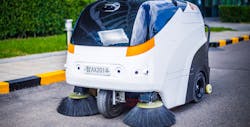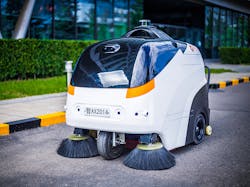Autonomous Sweepers Keep Roads Clean in Major Chinese Cities
When designing systems to anticipate what other drivers and pedestrians will do, automakers are finding that building self-driving vehicles is turning out to be harder, slower, and costlier than they thought. The same may not be true of limited application commercial vehicles, which may be adopted far sooner than driverless cars. Consider street-sweeping sanitation vacuums, for example—they’re essential to keeping any large city or town looking neat and clean.
Street sweepers in part take other vehicles and people out of the equation because drivers and pedestrians are accustomed to avoiding these vehicles when they’re encountered on the road.
In China, the Idriverplus street cleaning vehicle is an unmanned, purely electric solution to intelligently sweeping roads (see figure). The Chinese firm’s road sweeper, known as “Viggo,” automatically tracks and avoids obstacles as it cleans. More than 100 units are now in operation at universities, factories, parks, an amusement park, and city streets—with deployments in Beijing, Tianjin, Shanghai, Hebei, Zhejiang, Henan, Hunan, and other provinces and cities in China. Idriverplus also has strategic cooperation partnerships in Singapore, Dubai, Malaysia, and other areas in Asia.
Over 100 autonomous Idriverplus Viggo street sweepers are now in operation throughout China.
Velodyne LiDAR sensors are being used in all Idriverplus self-driving vehicles. They deliver the data that allows real-time object and free-space detection needed for safe navigation and reliable operation.
“We have a vision for the future that autonomous driving is not only a means of transportation, but also a necessity of life,” says Idriverplus CEO Dr. Zhang Dezhao. “LiDAR is indispensable in our development of autonomous-driving technology. “
Armed with LiDAR for long-distance detection and obstacle identification, cameras, an ultrasonic sensor for short-distance obstacle detection and avoidance, integrated navigation, and wheel-speed measurement sensors, Viggo has realized the goal of autonomous driving. It’s free from manual operation, undertaking cleaning and watering on road surfaces automatically.
The unit employs a UM482 positioning and heading module developed by Unicore Communications. The module, based on the company’s Nebulas II SoC, supports GPS L1/L2, BDS B1/B2, GLONASS L1/L2, and Galileo E1/E5b satellite signals. Integrated with on-board MEMS and Unicode’s U-Fusion technology, the UM482 is said to effectively solve the disruption of positioning results caused by the loss of satellite signal. Moreover, it further optimizes the continuity and reliability of positioning and heading outputs in complex environments such as city canyons, buildings, and tunnels.
Specs for Idriverplus’ independently developed Automated Vehicle Operating System (AVOS) include:
- Running mileage: 30-40 km (depending on working condition)
- Working conditions: −20~40℃
- Charging time: 4-5 hours
- Battery capacity: 200 Ah
- Battery type: ternary lithium battery
- Net weight: 395 kg
- Hopper capacity: 60 L
- Duration 6-8 hours
Idriverplus also is developing two other commercial autonomous car solutions: an SAE Level 4 vehicle that provides autonomous driving in closed parks and some public roads, and an advanced driver-assistance system (ADAS) solution for automatic parking (AVP) and highway work permit (HWP) applications.
Its WOBIDA product applies self-driving technology to the logistics and distribution industry using an automatic driving system combined with a cloud-platform management system for the intelligence required in the last kilometer of logistical package delivery. WOBIDA provides 360-degree process monitoring and real-time information interaction as well as what’s called an “intelligent” storage cabinet for transporting goods.
In Beijing’s Zhongguancun Changping Science Park, the self-driving logistics vehicle has already started operation. When an obstacle appears, it slows down and stops immediately. The front and rear cameras are used to detect lane lines and surrounding pedestrian vehicles and adjust its position at any time.
Idriverplus says it has simulated different road conditions to test its self-driving algorithm. The company adds that its driverless vehicles have now clocked in excess of 400,000 kilometers, which it claims puts it ahead of other Chinese autonomous vehicle manufacturers.


